Classic Pasta Amatriciana
Pasta Amatriciana is a classic Italian pasta dish, it’s a hearty and flavorful dish. It’s easy to make which makes it perfect for a weeknight meal but so delicious it even makes the perfect special occasion meal.
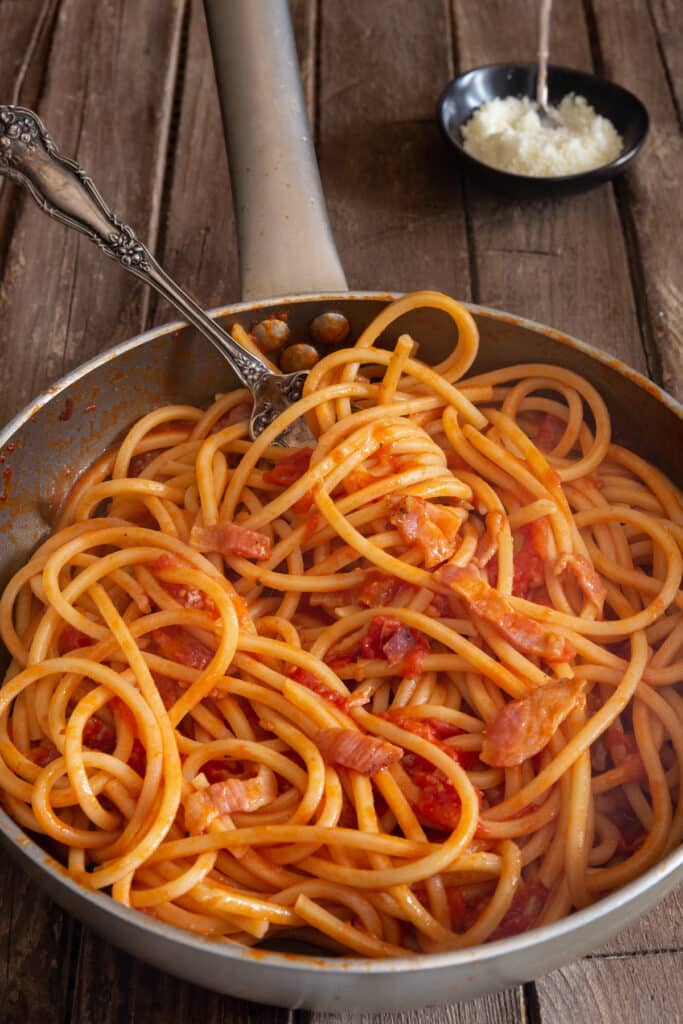
This was probably one of the first pasta sauces that I tasted when I first came to Italy. It was naturally made by my mother-in-law. I know a lot of people will fight me on this but yes she made it with pancetta. Probably because my brother-in-law couldn’t stand the idea of guanciale.
Although I now make it with guanciale because we do prefer it that way. Authentic Amatriciana and of course Carbonara are both made with guanciale. Italians can be very defensive about their authentic pasta dishes from Cacio e Pepe to Pasta Puttanesca to of course Alfredo pasta.
Pasta Amatriciana is a classic Italian pasta dish, it’s a hearty and flavorful dish. It’s easy to make which makes it perfect for a weeknight meal but so delicious it even makes the perfect special occasion meal.
This was probably one of the first pasta sauces that I tasted when I first came to Italy. It was naturally made by my mother-in-law. I know a lot of people will fight me on this but yes she made it with pancetta. Probably because my brother-in-law couldn’t stand the idea of guanciale.
Although I now make it with guanciale because we do prefer it that way. Authentic Amatriciana and of course Carbonara are both made with guanciale. Italians can be very defensive about their authentic pasta dishes from Cacio e Pepe to Pasta Puttanesca to of course Alfredo pasta.
I have used both, I personally I prefer pancetta, although my daughter swears you can’t make this recipe or Classic Carbonara without guanciale. So you decide.
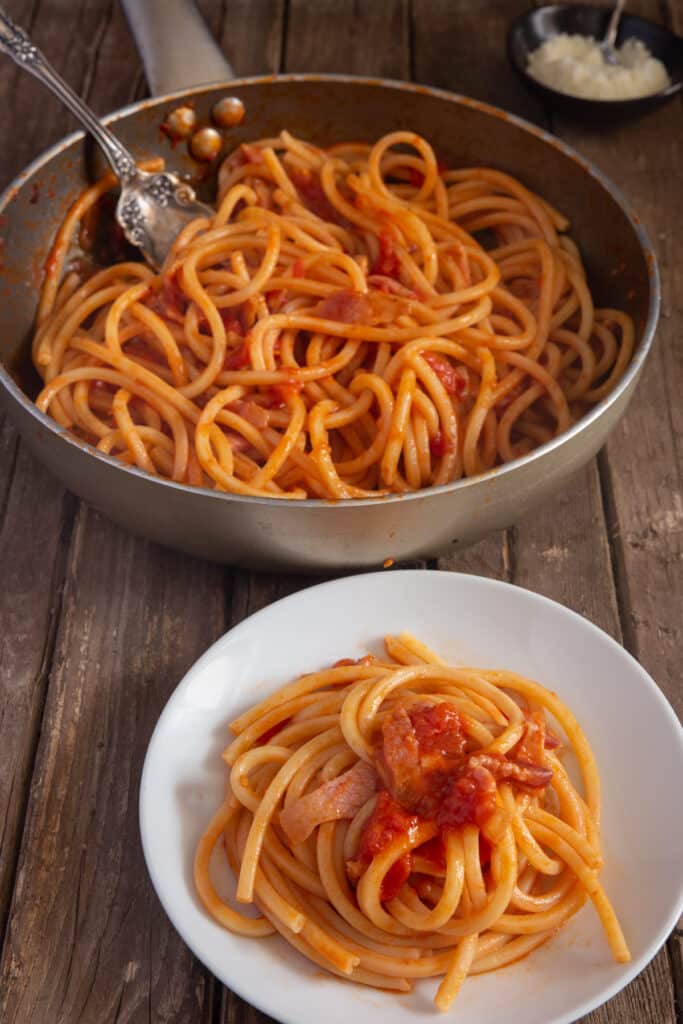
Ingredients to make Amatriciana
- Guanciale – also known as pork jowl
- Olive oil – good quality extra virgin olive oil
- Tomatoes – canned san marzano tomatoes peeled
- Pecorino – freshly grated pecorino romano cheese
- Wine – a good quality dry white wine
- Pepper – red pepper flakes or a fresh pepper also known as chili pepper
- Pasta – bucatini

What is the difference between pancetta and guanciale?
Pancetta is salt-cured seasoned pork belly, while guanciale is made from seasoned pork cheeks that is cured for at least three months, which as a result has a more intense flavour.
if you can’t find guanciale then you can definitely use pancetta. I personally prefer pancetta, although my daughter swears you can’t make this recipe or Authentic Carbonara without guanciale! So you decide.
How to make Amatriciana Sauce
In a medium pan add the olive oil and guanciale, cook until golden.
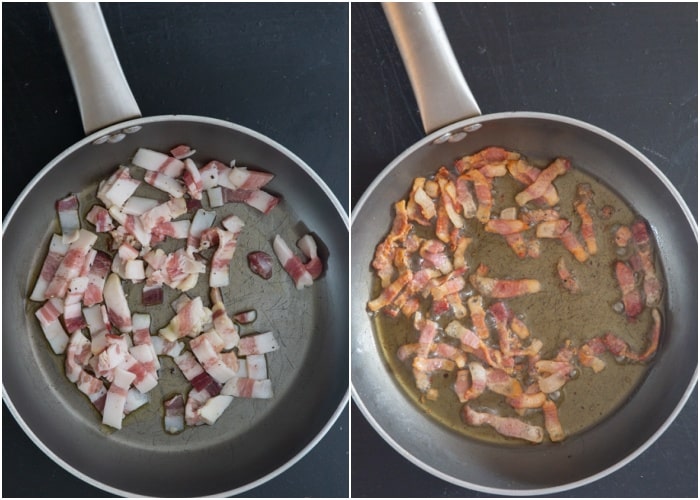
When starting to turn golden add the wine and cook on high heat for 1-2 minutes until the alcohol has evaporated. Remove the guanciale and liquid from the pan.

To the pan add a little more olive oil, the tomatoes lightly crushed, hot pepper flakes.

Add a little liquid from the pan cook until thickened.

Add a little pasta water and the pasta al dente, gently toss to combine, add the guanciale.
Cook a couple of minutes on high tossing constantly, if needed add a bit more pasta water. Taste for salt and adjust if needed.

Add the pecorino and toss, cooking on low until creamy. Serve immediately, top with more freshly grated pecorino cheese if desired.
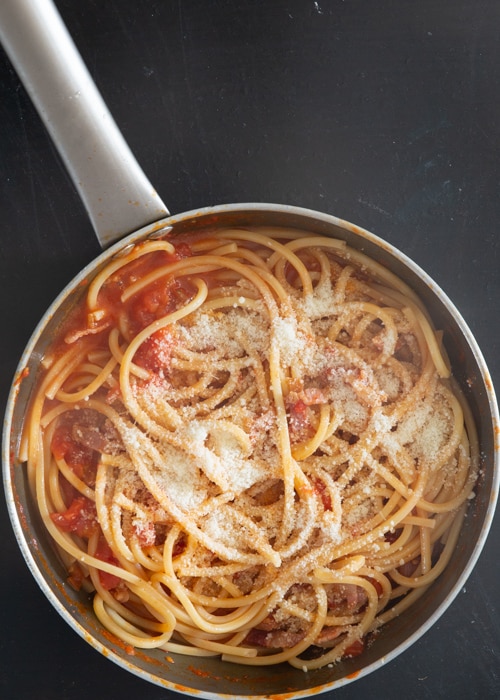
How to cook pasta
Always cook the pasta in enough water, you will need 4 cups (1 litre) for 3 1/2 ounces (100 grams) of pasta. Be sure to choose the correct size large pot, you don’t want the water to reach the rim and overflow, because pasta, when cooked, can increase in volume up to three times. Always cover the pot when boiling the water, but remove it once the pasta has been added.
Calculate about 7 g of salt for every litre of water. Add the salt only when the water has reached a boil and never before.
After adding the pasta to the salted water, bring it back to a boil and keep it at a boil while the pasta is cooking. This allows the pasta to achieve an even cooking, be sure to stir frequently while it is cooking.
Never pass the freshly drained pasta under running tap water. You should never stop the cooking, even when you are making a cold pasta salad, let it cool by adding a drizzle of olive oil to prevent it from sticking.
Drain the pasta al dente, this is done by tasting, if it has a bite to it it’s ready, nothing worse than mushy pasta. If you have to toss the pasta in a pan with sauce (like this recipe) then cook it at least one minute less (pasta very al dente). And be sure to leave some pasta water to add to the pan.
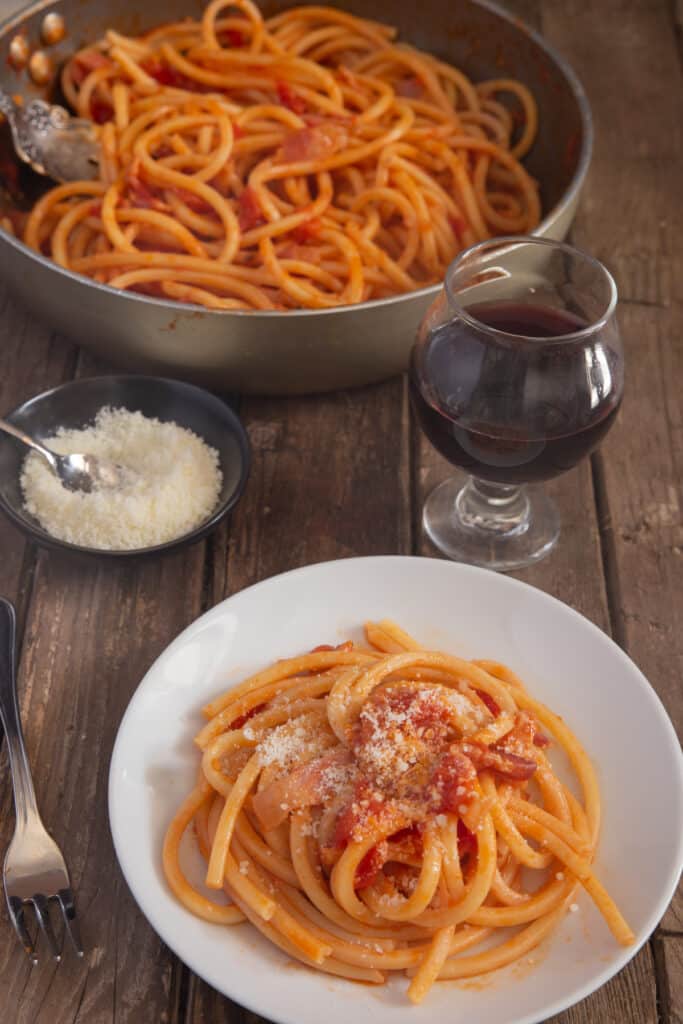
What does Amatriciana mean?
It is a tomato based sauce, made with guanciale or pancetta and it is usually a little hot and spicy. It originates from the town of Amatrice in the province of Rieti, in the region of northern Lazio which is located in central Italy.
History of Pasta Amatriciana
This pasta dish dates back to the 18th century. It was originally made by shepherds who lived in the hills around Amatrice. They would use guanciale (cured pork cheek), tomatoes, and pecorino cheese to create this hearty and flavorful pasta dish, it would sustain them during their long hard days of work.
Amatriciana recipe FAQs
Instead of guanciale you can substitute with pancetta you could also substitute the pecorino with freshly grated parmigiano reggiano (parmesan cheese). I have known some to use a sliver of onion, but we prefer it without.
The classic pasta used in this recipe is bucatini, it is a thick long pasta with a hole in the middle. Although I have to say the Italian prefers “mezze penne rigate”, which is a short pasta with ridges. The ridges are known to hold the sauce better. My mother-in-law would also use spaghetti sometimes too.
How to store the sauce
The sauce can be stored in an air tight container in the fridge for two days. It can also be frozen in a freezer safe bag or container. It will last up to three to four months.
Pasta Amatriciana is a classic Italian pasta dish that’s hearty, flavorful, and easy to make at home. With its rich history and delicious ingredients, I hope you enjoy it as much as we do. Buon Appetito!
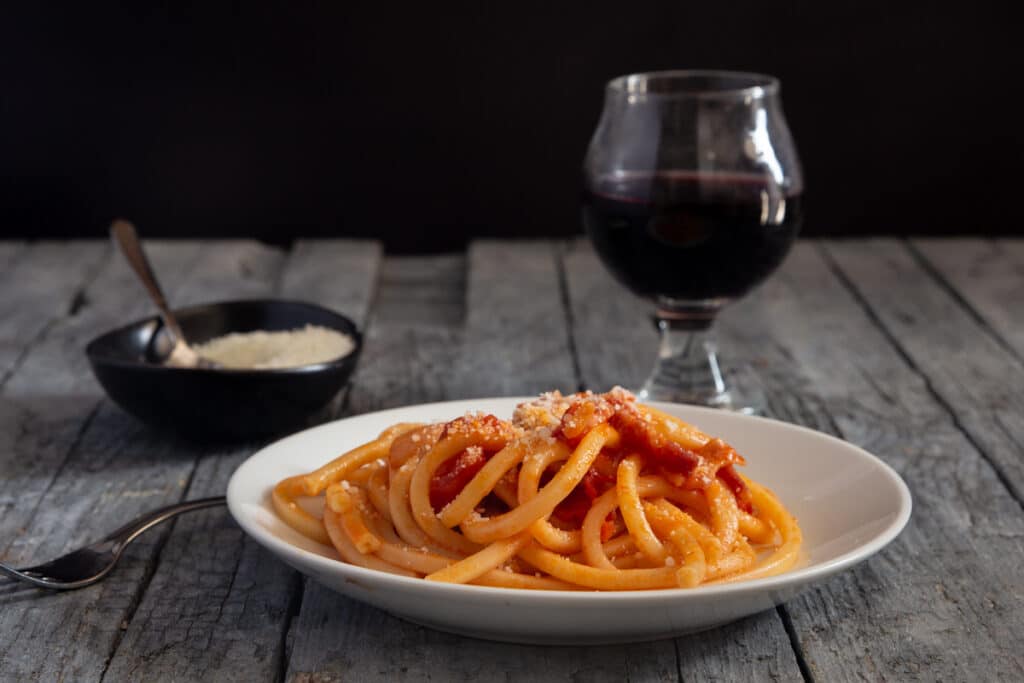

Classic Pasta Amatriciana
Ingredients
- 2 tablespoons olive oil (divided)
- ¾ cup guanciale (chopped)
- ¼ cup white dry wine
- 1 can peeled Roma or Marzano (tomatoes with juice no additives) 1 1/2 – 2 cups chopped
- 1-2 dashes pinches hot pepper flakes or black pepper
- 4-5 tablespoons freshly grated pecorino cheese
- 3- 3½ cups pasta al dente*
*Depending on the pasta but usually double the amount of dry to get cooked.
Instructions
- In a large pot of salted boiling water cook the pasta until very al dente.
- In a medium pan add the olive oil and guanciale, cook until golden. When starting to turn golden add the wine and cook on high heat for 1-2 minutes until the alcohol has evaporated. Remove the guanciale and liquid from the pan to a clean bowl.
- To the empty pan add a tablespoon of olive oil, the tomatoes lightly crushed, hot pepper flakes or pepper and 2-3 tablespoons of the liquid from the cooked guanciale. Cook on medium high until thickened.
- Then and 2-3 tablespoons pasta water, the al dente pasta and cook on medium-high tossing for two minutes. Add the hot pepper flakes or black pepper, an extra tablespoon or two of pasta water and grated pecorino continue to cook tossing constantly until creamy, approximately one minute. Serve immediately with extra pecorino if desired. Enjoy!
Before adding the pecorino taste and adjust for salt. If your pecorino is extra salt, salt may not be needed.
Notes
Nutrition
Updated from June 16, 2014.
Guanciale is super expensive down this way. In the $30-40 / lb range. We make this with sliced smoked bacon (any brand) and it is amazing.
Hi Richard, yes it is good with pancetta also. Take care!
Delicious!! This was a lovely culinary trip back to our time in Rome in October. How things have changed since then ☹️
Thank you for posting these wonderful recipes!
Hi Sarah, thanks, glad I could bring back some happy memories at this time. I hope you get to return one day. Take care.
While tasty, tomato, we think we should have doubled the pancetta to offer more taste above the tomato. We will make this again and add some pancetta in hopes to get a little more “pancetta” flavor. This first time we used Bucatoni; next time we will the the Italian’s favorite; short pasta.
Hi DJ, thanks let me know with the extra pancetta and the short pasta. 🙂
First try today. How many dry ounces of pasta is equal to 3-cups cooked pasta????
Have loved each of your recipes to date…..
Hi DJ about 1 1/2 – 2 cups dry is equal to 3 cups cooked. Let me know how you like it.
That photo is making me crave pasta for breakfast! So gorgeous!
Hi Jessica, thanks and why not?
OMG This looks amazing… Mouthwatering! I must admit I LOVE pasta and this sause is one of my very favorites!!!
XOXO
Hi, thanks, I must say it is my daughter’s favourite, she never gets tired of it.
Making this tonight!!!
Hi Lena, let me know how it turns out.
Hello!
I saw your blog and thought it had great recipes and awesome pictures! I therefore would like to invite you to our new culinary website which has just started.
This is how it works in short. TastyQuery.com is a website for food bloggers and their fans allowing them to automatically collect recipes from your food blog. It’s a large database of links to recipes on food blogs. Everyone can join us for free.
For more please visit:
http://tastyquery.com
TastyQuery.com is an English version of our main website called “Mikser Kulinarny”, founded in Poland. “Mikser Kulinarny” has a large audience (over 2 mln unique visitors monthly) and with TastyQuery.com we want to repeat that success and drive thousands of new visitors to your food blog.
In case of any questions, don’t hesitate to contact us.
Best regards
Agnieszka
Hello Agnieszka, thanks very much, I will for sure check out your new culinary website.